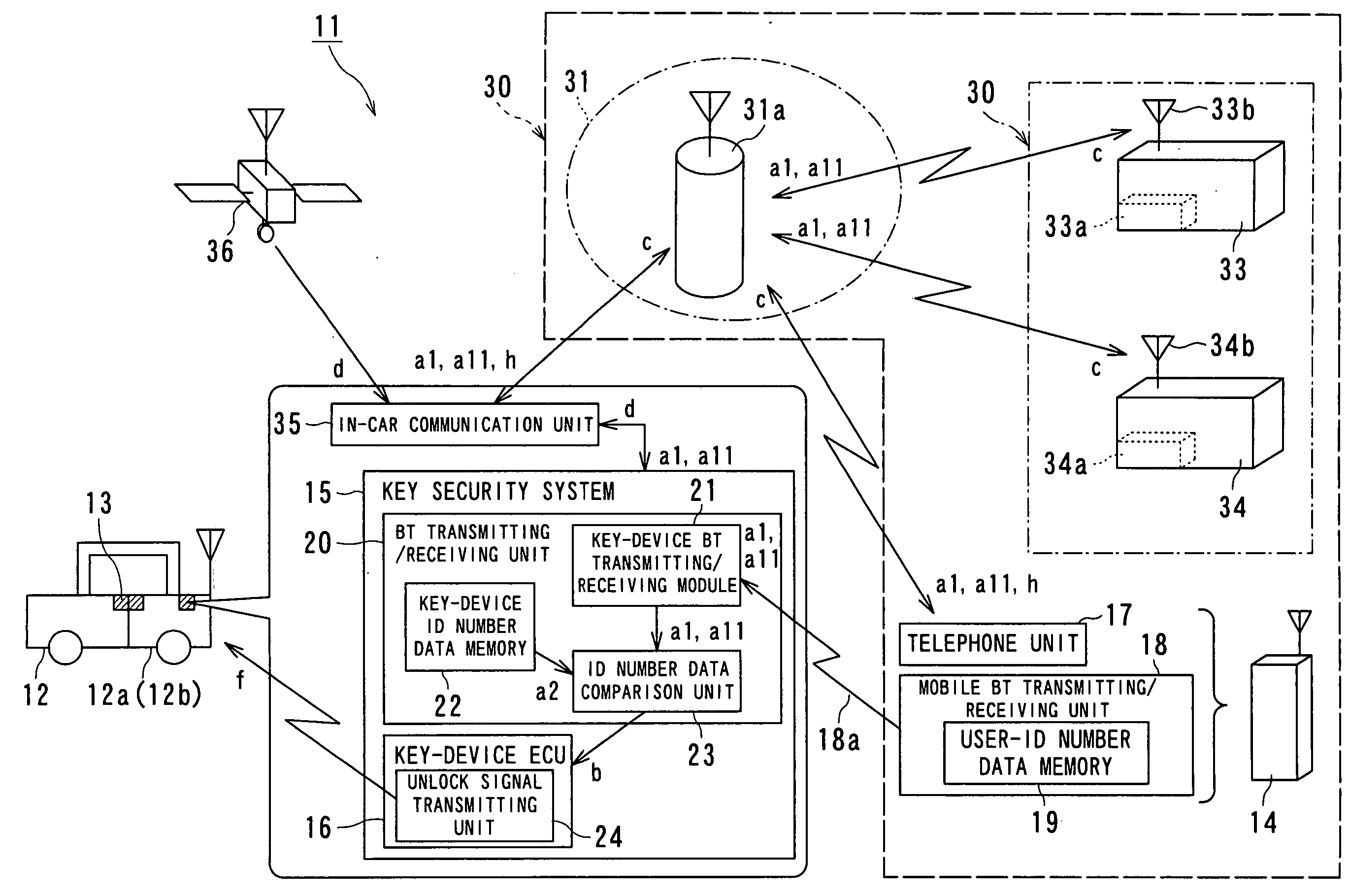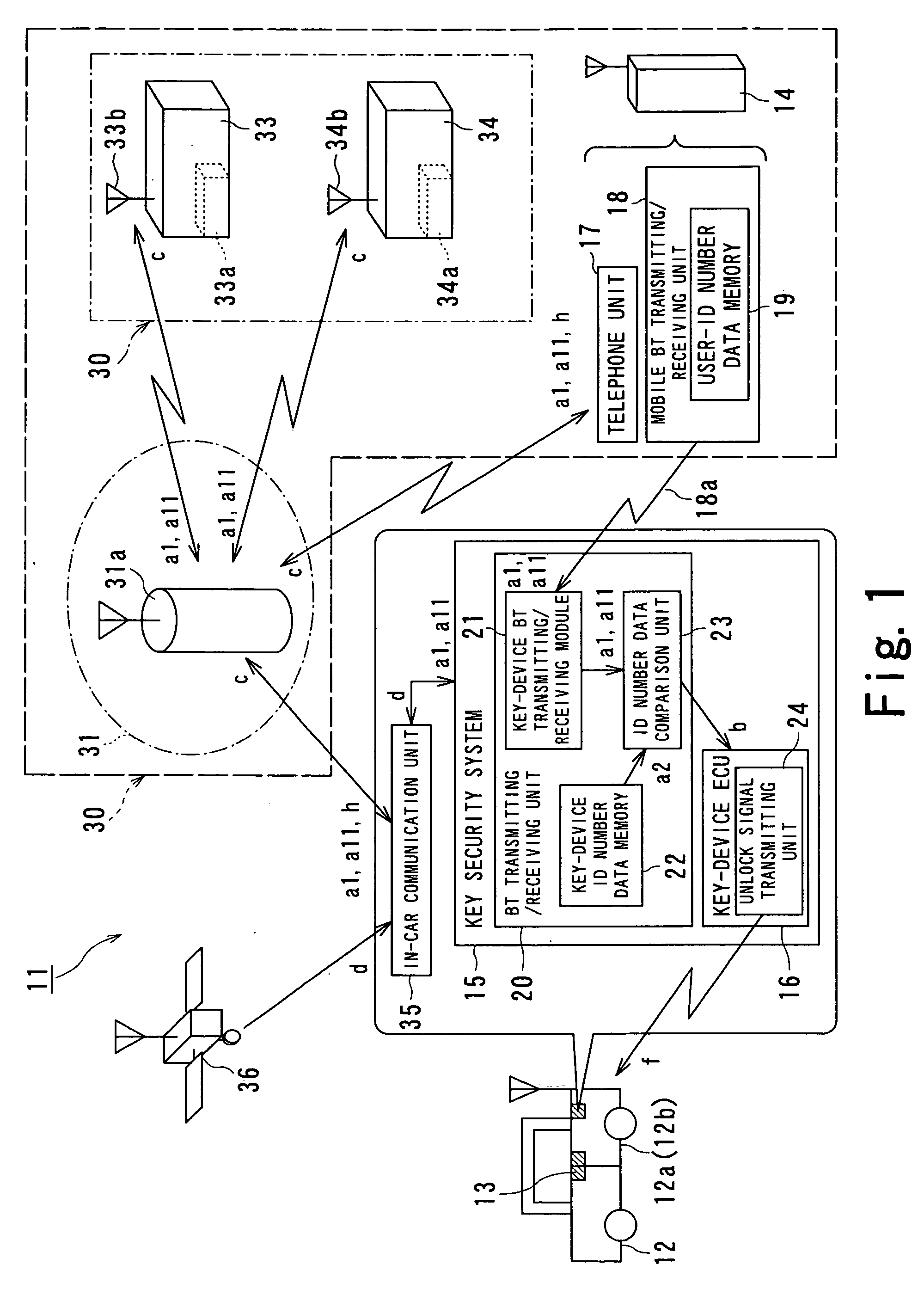Keyless entry system and keyless entry method
- Summary
- Abstract
- Description
- Claims
- Application Information
AI Technical Summary
Benefits of technology
Problems solved by technology
Method used
Image
Examples
first embodiment
[0028]FIG. 1 is a schematic diagram of a keyless entry system according to the first embodiment of the present invention.
[0029] A keyless entry system 11 includes a key device 13 mounted on a vehicle 12 for locking and unlocking a door and a key security system 15 mounted on the vehicle 12 and having a function capable of communicating with a mobile terminal 14.
[0030] The key device 13 is used for a driver or a passenger of the vehicle 12 (hereinafter referred to as a “user”) to lock and unlock doors 12a and 12b (only one side is shown) either remotely using the mobile terminal 14 or automatically.
[0031] The key device 13 can be operated by an owner of the vehicle 12 and a person who received the permission to drive the vehicle 12 from the owner (hereinafter referred to as a “user”) either remotely using the mobile terminal 14 with respect to the vehicle 12 or automatic recognition at a time of getting on and off the vehicle 12.
[0032] The key device 13 receives user-ID number da...
second embodiment
[0097] The second embodiment of the present invention will be described next.
[0098] A keyless entry system according to the second embodiment is described with reference to FIG. 3, in which the same reference numerals are used to designate the same components or parts in FIG. 1.
[0099] According to this embodiment, a keyless entry system 41 is applied to the vehicle 12 mounting an immobilizer (anti-car theft system) 43, which controls starting an engine start device 42. The engine start device 42 is a key device which starts a (driving) engine (not shown) using a key.
[0100] The immobilizer 43 is a system that prevents the engine start device 42 of the driving engine from starting and stopping if a user of the vehicle 12 cannot be authenticated.
[0101] The immobilizer 43 includes a key-device Bluetooth transmitting / receiving unit 20 (hereinafter referred to as a “key-device BT transmitting / receiving unit”) and an engine ECU 44 which is a key-device ECU for transmitting an engine st...
third embodiment
[0121] A third embodiment of the present invention will be described next.
[0122] A keyless entry system according to the third embodiment is described with reference to FIG. 5, in which the same reference numerals are used to designate the same components or parts in FIG. 1.
[0123] According to the present invention, a keyless entry system 50 includes a key device 13 installed in, for example, a house 51, a mobile terminal 14, and a wireless security network 53 capable of connecting the mobile terminal 14 to a house security service site 52 via a regular wireless network 31.
[0124] In this third embodiment, basically, the house 51 may be considered as the vehicle 12 in the first embodiment shown in FIG. 1, and the in-car communication device 35 in the first embodiment shown in FIG. 1 may be considered to be eliminated from the wireless network.
[0125] That is, the house security service site 52 can communicate with the mobile terminal 14 via a communication antenna 52a and the hous...
PUM
 Login to View More
Login to View More Abstract
Description
Claims
Application Information
 Login to View More
Login to View More - R&D
- Intellectual Property
- Life Sciences
- Materials
- Tech Scout
- Unparalleled Data Quality
- Higher Quality Content
- 60% Fewer Hallucinations
Browse by: Latest US Patents, China's latest patents, Technical Efficacy Thesaurus, Application Domain, Technology Topic, Popular Technical Reports.
© 2025 PatSnap. All rights reserved.Legal|Privacy policy|Modern Slavery Act Transparency Statement|Sitemap|About US| Contact US: help@patsnap.com



